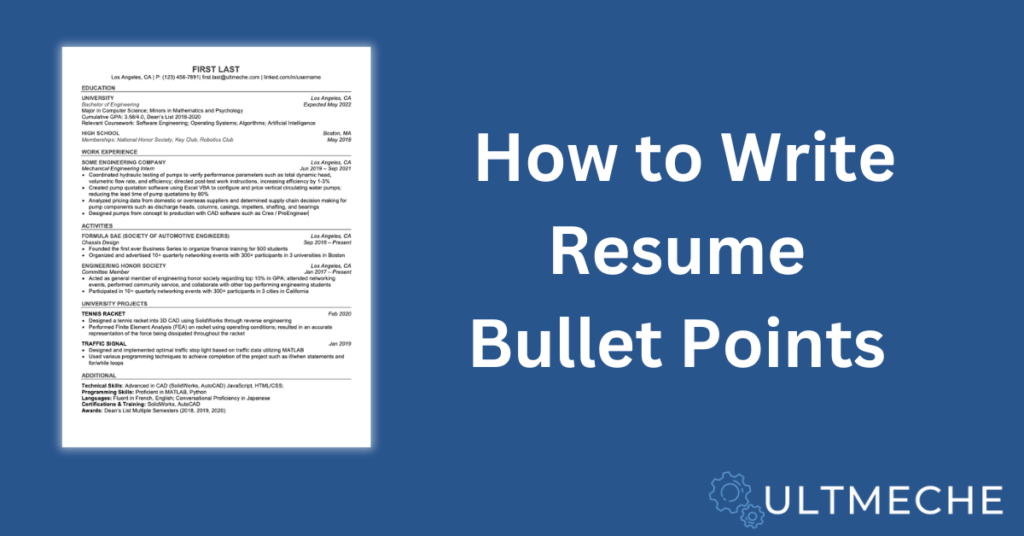When you’re aiming to establish yourself as a professional, your resume becomes a tool for showcasing your experience, skills, and qualifications to employers. The way you construct the bullet points on your resume can. Break that initial impression and determine whether you secure an interview. It’s essential to ensure that each bullet point is engaging and persuasive.
By following some tips for writing impactful resume bullet points, you can guarantee that your resume truly showcases your abilities and captures the attention of recruiters. Keep reading to discover how to transform your resume bullet points from dull to outstanding.
March 2, 2024
What Are Resume Bullet Points
Bullet points on a resume are powerful statements that showcase your experience, skills, and achievements. They enable you to effectively communicate the qualifications that position you as a competitive candidate for a job.
How to Write Resume Bullet Points Impactfully: The PAR Method
To write impactful bullet points on your resume using the PAR method, follow these guidelines:
Focus on achievements, not just responsibilities
The PAR technique, which stands for Problem, Action, Result, is an approach. When listing your accomplishments, it’s important to articulate the problem you faced, the action you took, and the measurable result or impact. Simply outlining responsibilities won’t effectively demonstrate your achievements and value.
Lead with a strong verb
To grab the reader’s attention and highlight your accomplishments, start each bullet point with a verb such as “reduced,” “increased,” “transformed,” “pioneered,” “spearheaded,” or “revamped.”
Use numbers and metrics
Whenever possible, provide results and impacts. For instance, you could mention reducing customer complaints by 25% year over year or improving page load times by 0.5 seconds, resulting in a 15% increase in conversion rate. Including statistics and metrics strengthens your bullet points.
Tailor to the position
Customize your resume for each job by focusing on highlighting achievements and measurable impacts that align with the job requirements. Utilize language from the job listing. Emphasize skills.
Check for conciseness and parallel structure
Keep your bullet points concise at around 1 to 2 lines or 50 to 100 characters in length. Maintain structures within the same section. For example, start each point with a verb. Begin each achievement statement in a manner.
Proofread carefully
Ensure there are no typos or grammatical errors by reviewing your resume. Before sending out your resume, it’s always an idea to have a friend or family member review it to make sure there are no mistakes. Crafting bullet points that are both impactful and concise while also being tailored specifically to the job you’re applying for will leave an impression on hiring managers. It’s crucial to ensure that your resume is error-free.
Resume Bullet Point Formatting Tips
When crafting resume bullet points, follow these formatting tips to make your key accomplishments and qualifications stand out to employers:
Use Parallel Structure
For each position you list, use the same pattern or structure for all bullet points. For example:
- Reduced customer wait time by 25% by implementing a new scheduling system
- Streamlined order fulfillment process, decreasing delivery time by 15%
- Reorganized warehouse layout, resulting in improved productivity and accuracy
Using the same grammatical form creates a clean, organized look. The parallel structure also makes your bullet points easier to read and understand at a glance.
Start with Action Verbs
Start each bullet point with a strong action verb, like “decreased,” “optimized,” or “revamped,” to showcase your abilities and expertise. Try to avoid using verbs such as “aided,” “assisted,” or “worked.” Action verbs add an enthusiastic tone to your bullet points.
Common Resume Bullet Point Mistakes to Avoid
When crafting bullet points for your resume, it is important to avoid several common mistakes that could reflect poorly on you as a candidate. Make sure to avoid these mistakes while learning how to write resume bullet points.
Being Too Wordy
When crafting your bullet points, it’s important to keep them concise and avoid details. Focus on highlighting achievements and essential qualifications. Lengthy or irrelevant bullet points may not effectively communicate your skills and experience to the reader.
Using Complete Sentences
Remember that bullet points should be phrases rather than complete sentences. Each one should succinctly showcase an accomplishment or qualification. Using sentences can make your bullet points appear crowded and difficult to read.
Repeating Information
Avoid repeating information that is already covered in your resume summary statement or work experience descriptions. Bullet points should provide context. Emphasize measurable accomplishments rather than restating details already mentioned. Repetition can come across as redundant. Waste space on the page.
Using Passive Language
Use verbs and a compelling writing style for your bullet points. Steer clear of mundane language like “Responsible for…”. Duties included…”. Instead, focus on concise phrases that begin with strong action verbs showcasing your contributions and impact. Employing active, engaging bullet points will help you stand out as a candidate.
Lacking Quantifiable Information
Whenever possible, include achievements and key performance indicators in your bullet points. Then, describing general responsibilities and duties highlights specific results you have achieved. Highlighting your accomplishments and the positive outcomes they bring is crucial in showcasing your value to employers. Bullet points that lack details can come across as vague and less persuasive. To ensure your bullet points have an impact, it’s important to avoid these errors. By selecting the information you wish to convey and carefully choosing your words, you can create bullet points that effectively demonstrate your experience, skills, and worth, ultimately increasing your chances of securing an interview.
See below for examples on how to write resume bullet points.
Examples of Good Resume Bullet Points by Industry
To effectively communicate your qualifications for a position, your resume bullet points should be concise yet compelling. Tailor your bullet points to the specific job and industry. Here are some examples of effective resume bullet points for different roles:
Technology
- Optimized page load times by 50% through code refactoring and migration to microservices architecture.
- Reduced infrastructure costs by 30% annually by automating deployment through CI/CD pipelines.
- Improved data security by implementing end-to-end encryption and two-factor authentication.
Marketing
- Increased social media engagement by 40% year over year through targeted digital ad campaigns.
- Redesigned website experience, improving conversion rates by 25%.
- Created innovative content marketing strategy, boosting monthly blog traffic by 50% in 6 months.
Sales
- Exceeded sales targets by an average of 15% each quarter through data-driven prospecting and account management.
- Reduced sales cycle by 20% and increased deal size by 30% by focusing on enterprise accounts.
- Strengthened client relationships and drove repeat business through personalized customer service.
Healthcare
- Provided compassionate care to over 200 patients per month in a fast-paced healthcare environment.
- Optimized clinic efficiency by 10% through streamlining patient intake and triage processes.
- Maintained HIPAA compliance and ensured patient data security through routine audits and staff education.
Conclusion
When writing your resume bullet points, it is crucial to be specific and provide accomplishments. Focus on highlighting the impact you had in each role to make an impression on employers. Your resume serves as your opportunity to showcase your value to the organization, so invest time in crafting bullet points that clearly demonstrate how you can contribute.
By doing so, you increase your chances of progressing to the stage of the interview process and getting closer to securing your dream job. With practice and dedication, you will develop compelling resume bullet points that set you apart from candidates.
Ready to take your job search to the next level?
Book a career service with us, get started, and see 10X more interviews and job offers.
About the author

Kazuyoshi Fujimoto, PE
Founder | Engineering Career Coach | Principal Mechanical Engineer
Kazu oversees all of ultmeche’s engineering services. He provides consulting such as resume reviews, rewrites, mock interviews, and all services career related. Additionally, Kazu performs consulting work regarding Oil & Gas, Automotive, and Aerospace & Defense. Kazu is licensed as a professional engineer in the state of California and has 9+ years of experience in Oil & Gas, Automotive, and Aerospace & Defense.

3 thoughts on “How to Write Resume Bullet Points”